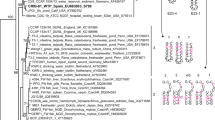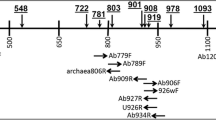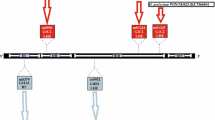Abstract
Novel 16S rRNA introns were detected in four new strains within the family Thermoproteaceae. Pyrobaculum oguniense TE7T and Thermoproteus sp. IC-062 housed introns of 32 and 665–668 bp after positions 1205 and 1213 (Escherichia coli numbering system), respectively. Caldivirga maquilingensis IC-167T had two introns of 37 and 140 bp after positions 901 and 908, respectively. Vulcanisaeta distributa IC-065 had a 691-bp intron after position 1391. All the introns larger than 650 bp encoded the LAGLI-DADG type proteins. The intron-encoded proteins of P. oguniense TE7T and Thermoproteus sp. IC-062 are cognate with the proteins encoded by introns inserted at the same position in other Pyrobaculum/Thermoproteus strains and phylotypes. The intron-encoded protein of V. distributa IC-065 is partially related to that of a Pyrobaculum phylotype. A large-scale deletion in the second intron of Caldivirga maquilingensis IC-167T is suspected. Based on these newly found introns and hitherto known 16S rRNA introns, the evolutionary movements of the 16S rRNA introns and the encoded LAGLI-DADG type proteins are discussed.



Similar content being viewed by others
References
Aagaard C, Dalgaard JZ, Garrett RA (1995) Intercellular mobility and homing of an archaeal rDNA intron confers a selective advantage over intron- cells of Sulfolobus acidocaldarius. Proc Natl Acad Sci USA 92:12285–12289
Belfort M, Perlman PS (1995) Mechanisms of intron mobility. J Biol Chem 270:30237–30240
Belfort M, Roberts RJ (1997) Homing endonucleases: keeping the house in order. Nucleic Acid Res 25:3379–3388
Burggraf S, Larsen N, Woese CR, Stetter KO (1993) An intron within the 16S ribosomal RNA gene of the archaeon Pyrobaculum aerophilum. Proc Natl Acad Sci USA 90:2457–2550
Chevalier BS, Stoddard BL (2001) Homing endonucleases: structure and functional insight into the catalysts of intron/intein mobility. Nucleic Acids Res 29:3757–3774
Dalgaard JZ, Garrett RA (1992) Protein-coding introns from the 23S rRNA encoding gene form stable circles in the hyperthermophilic archaeon Pyrobaculum organotrophum. Gene 121:103–110
Dalgaard JZ, Garrett RA, Belfort M (1993) A site specific endonuclease encoded by a typical archaeal intron. Proc Natl Acad Sci USA 90:5414–5417
Felsenstein J (1985) Confidence limits on phylogenies: an approach using the bootstrap. Evolution 39:783–791
Itoh T, Suzuki K, Nakase T (1998) Occurrence of introns in the 16S rRNA genes of members of the genus Thermoproteus. Arch Microbiol 170:155–161
Itoh T, Suzuki K, Sanchez PC, Nakase T (1999) Caldivirga maquilingensis gen. nov., sp. nov., a new genus of rod-shaped crenarchaeote isolated from a hot spring in the Philippines. Int J Syst Bacteriol 49:1157–1163
Itoh T, Suzuki K, Nakase T (2002) Vulcanisaeta distributa gen. nov., sp. nov. and Vulcanisaeta souniana sp. nov., hyperthermophilic, rod-shaped crenarchaeotes isolated from hot springs in Japan. Int J Syst Evol Microbiol 52:1097–1104
Kjems J, Garrett RA (1985) An intron in the 23S ribosomal RNA gene of the archaebacterium Desulfurococcus mobilis. Nature 318:675–677
Kjems J, Garrett RA (1991) Ribosomal RNA introns in archaea and evidence for RNA conformational changes associated with splicing. Proc Natl Acad Sci USA 88:439–443
Lauerer G, Kristjansson JK, Langworthy TA, König H, Stetter KO (1986) Methanothermus sociabilis sp. nov., a second species within the Methanothermaceae growing at 97 °C. Syst Appl Microbiol 8:100–105
Lykke-Andersen J, Garrett RA (1994) Structural characteristics of the stable RNA introns of archaeal hyperthermophiles and their splicing junctions. J Mol Biol 243:846–855
Lykke-Andersen J, Aagaard C, Semionenkov M, Garrett RA (1997) Archaeal introns: splicing, intercellular mobility and evolution. Trends Biochem Sci 22:326–331
Morinaga Y, Nomura N, Sako Y, Uchida A (2000) Substrate recognition of homing endonuclease I–Ape I in a hyperthermophilic archaeon (Abstract). Third International Congress on Extremophiles, Hamburg, Germany, p 212
Nomura N, Sako Y, Uchida A (1998) Molecular characterization and postsplicing fate of three introns within the single rRNA operon of the hyperthermophilic archaeon Aeropyrum pernix K1. J Bacteriol 180:3635–3643
Saitou N, Nei M (1987) The neighbor-joining method: a new method for reconstructing phylogenetic trees. Mol Biol Evol 4:406–425
Sako Y, Nunoura T, Uchida A (2001) Pyrobaculum oguniense sp. nov., a novel facultative aerobic and hyperthermophilic archaeon growing at up to 97 °C. Int J Syst Evol Microbiol 51: 303–309
Takai K, Horikoshi K (1999) Molecular phylogenetic analysis of archaeal intron-containing genes coding for rRNA obtained from a deep-subsurface geothermal water pool. Appl Environ Microbiol 65:5586–5589
Tamoka J (1994) Determination of DNA base composition. In: Goodfellow M, O'Donnell AG (eds) Chemical methods in prokaryotic systematics. Wiley, Chichester, pp 463–470
Thompson JD, Higgins DG, Gibson TJ (1994) Clustal W: improving the sensitivity of progressive multiple sequence alignment through sequence weighting, position-specific gap penalties and weight matrix choice. Nucleic Acids Res 22:4673–4680
Thompson JD, Gibson TJ, Plewniak F, Jeanmougin F, Higgins DG (1997) The CLUSTAL X windows interface: flexible strategies for multiple sequence alignment aided by quality analysis tools. Nucleic Acids Res 25:4876–4882
Watanabe Y, Yokobori S, Inaba T, Yamagishi A, Oshima T, Kawarabayashi Y, Kikuchi H, Kita K (2002) Introns in protein-coding genes in Archaea. FEBS Lett 510:27–30
Author information
Authors and Affiliations
Corresponding author
Additional information
Communicated by K. Horikoshi
Rights and permissions
About this article
Cite this article
Itoh, T., Nomura, N. & Sako, Y. Distribution of 16S rRNA introns among the family Thermoproteaceae and their evolutionary implications. Extremophiles 7, 229–233 (2003). https://doi.org/10.1007/s00792-003-0314-y
Received:
Accepted:
Published:
Issue Date:
DOI: https://doi.org/10.1007/s00792-003-0314-y




